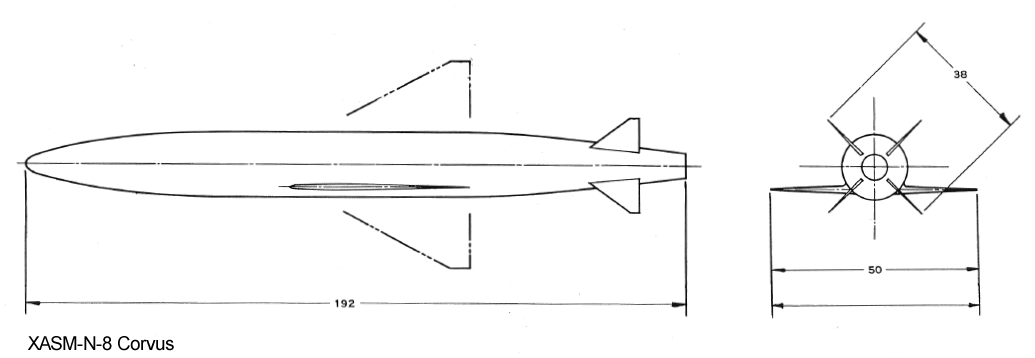ASM-N-8 Corvus on:
[Wikipedia]
[Google]
[Amazon]
The ASM-N-8 Corvus was an
 The XASM-N-8 had two delta wings and cruciform tailfins for flight stability and control. It was powered by a
The XASM-N-8 had two delta wings and cruciform tailfins for flight stability and control. It was powered by a
File:A4D-2 with two ASM-N-8 Corvus missiles.JPG, Artist's impression of an A4D-2 with two ''Corvus''-missiles
File:A-3B with Corvus missile at Point Mugu range.jpeg, XASM-N-8 ''Corvus'' on an A3D-2.
File:ASM-N-8 Corvus missile attack drawing.PNG, Planned mission profile for an ASM-N-8 attack.
anti-radiation missile
An anti-radiation missile (ARM) is a missile designed to detect and home in on an enemy radio emission source. Typically, these are designed for use against an enemy radar, although jammers and even radios used for communications can also be ...
developed by Temco Aircraft
The Texas Engineering & Manufacturing Company (TEMCO), also known as Temco Aircraft Corporation, was a U.S.-based manufacturing company located in Dallas, Texas, USA. It is best known for eventually forming part of the conglomerate Ling-Temco-V ...
for the United States Navy
The United States Navy (USN) is the maritime service branch of the United States Armed Forces and one of the eight uniformed services of the United States. It is the largest and most powerful navy in the world, with the estimated tonnage ...
.
History
In April 1955, the U.S. Navy planned the acquisition of a long-range air-to-surface missile armed with a nuclear warhead. This weapon should be carried by the carrier-based North American A3J Vigilante and Douglas A4D Skyhawk. This missile was named ASM-N-8 Raven. Later that year, the project was changed to a nuclear armed anti-radar missile, and renamed Corvus.Temco Aircraft
The Texas Engineering & Manufacturing Company (TEMCO), also known as Temco Aircraft Corporation, was a U.S.-based manufacturing company located in Dallas, Texas, USA. It is best known for eventually forming part of the conglomerate Ling-Temco-V ...
was awarded a development contract in January 1957. The first flight of an XASM-N-8 missile occurred in July 1959. By March 1960, fully guided flights had been made at the Pacific Missile Test Center
Pacific Missile Test Center (PMTC) is the former name of the current Naval Air Warfare Center, Weapons Division. The name of the center was the Naval Air Missile Test Center prior to PMTC. It is located at Naval Base Ventura County/Naval Air Stat ...
at Point Mugu, California
Point Mugu (, Chumash: ''Muwu'') is a cape or promontory within Point Mugu State Park on the Pacific Coast in Ventura County, near the city of Port Hueneme and the city of Oxnard. The name is believed to be derived from the Chumash Indian te ...
. However, the program was cancelled in July 1960, when the overall responsibility for long-range nuclear air-to-surface missiles was transferred to the United States Air Force
The United States Air Force (USAF) is the Aerial warfare, air military branch, service branch of the United States Armed Forces, and is one of the eight uniformed services of the United States. Originally created on 1 August 1907, as a part ...
, which had no use for the ''Corvus'' missile.
Specifications
Thiokol
Thiokol (variously Thiokol Chemical Corporation(/Company), Morton Thiokol Inc., Cordant Technologies Inc., Thiokol Propulsion, AIC Group, ATK Thiokol, ATK Launch Systems Group; finally Orbital ATK before becoming part of Northrop Grumman) was an ...
liquid-fueled rocket, which gave it a range of 315 km for high-altitude launches and 185 km for low-altitude launches. Normally the missile would use a passive radar seeker and home on shore-based and ship-based radars. It could also home on non-radiating targets which were illuminated by a radar of the launching aircraft. The ''Corvus'' missile was to be armed with a W-40 nuclear warhead of 10 kt yield.
Gallery
See also
References
{{USN missiles ASM-N-008 ASM-N-008 ASM-N-8 Naval weapons of the United States